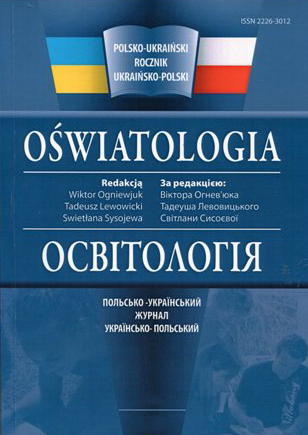INTERCULTURAL EDUCATION TECHNOLOGY OF STUDENTS IN EXTRACURRICULAR WITH MUSIC
DOI:
https://doi.org/10.28925/2226-3012.2016.5.127131Keywords:
educational technology, technology, intercultural education technology of studentsAbstract
In the article the intercultural education technology of students in extracurricular work by means of music; the essence and basic features of music and educational technology; examples of educational music-teaching technologies; described the stages of implementation of educational technology. The author analysis the basic principles of intercultural education content selection means music students in extracurricular work formulated and substantiated the content of education students, which includes two parts: theoretical and practical.
The content of the theoretical unit aimed at fostering cultural values and tolerance towards university students to general and music culture of Western Europe (Germany, Austria, Italy, France) and Far East (Mongolia, China, Korea, Japan) based on mastering their theoretical knowledge and skills to identify specific ethnic and typological features musical culture of these countries; musical styles and genres, and features folk and spiritual music, classics, works by contemporary composers each country.
Practical unit content of intercultural education of students by means of music in classroom work aimed at fostering intercultural communication skills, identifying specific in the musical culture of different nations, tolerance towards musical culture of other countries during the learning of theoretical material.
References
Гончаренко С. У. Зміст загальної освіти і її гуманітаризація / С. У. Гончаренко // Неперервна професійна освіта : проблеми, пошуки, перспективи: [монографія] / за заг. ред. І. А. Зязюна. – Київ : ВІПОЛ, 2000.– С. 81–107.
Єрастова-Михалусь І. Б. Формування міжкультурної толерантності майбутніх магістрів економіки: дис. ... к-та пед. наук : 13.00.04 / Інна Борисівна Єрастова-Михалусь ; Харківський національний економічний університет імені Семена Кузнеця. – Харків, 2016. – 164 с.
Мижериков В. А. Словарь-справочник по педагогике [Текст] / В. А. Мижериков / подобщ. ред.
П. И. Пидкасистого. – М. : ТЦ Сфера, 2004. – 448 с.
Неменский Б. М. Обращаясь к разуму и сердцу / Б. М. Неменский // Искусство и школа. – М. : Про- свещение, 1981. – С. 176–178.
Олексюк О. М. Музична педагогіка : Навчальний посібник / Ольга Миколаївна Олексюк. – К. : КНУКІМ, 2006. – 188 с.
Падалка Г. М. Педагогіка мистецтва (Теорія і методика викладання мистецьких дисциплін) / Г. М. Падалка. – Київ : Освіта України, 2010. – 274 с.
Сисоєва С. О. Інтегративні технології навчання дорослих : навч. – метод. посіб./ Світлана Олександрівна Сисоєва ; НАПН України, Київ, ун-т імені Бориса Грінченка. – Київ : ЕКМО, 2011. – 320 с.
Стукаленко З. М. Формування професійної толерантності майбутнього вчителя музичного мистецтва в процесі фахової підготовки: дис. ... к-та пед. наук : 13.00.04 / Зоя Михайлівна Стукаленко; Кіровоградський державний педагогічний університет імені Володимира Винниченка. – Кіровоград, 2016. – С. 86.
Талызина Н. Ф. Управление процессом усвоения знаний / Н. Ф. Талызина. – М. : Московский ун-т, 1975. – 343 с.
Фільц Б. М. Програма для загальноосвітніх навчальних закладів. Музичне мистецтво. 5–8 класи / укладач Б. М. Фільц. – Київ; Ірпінь, 2005. – С. 3–59.
Черкасов В. Ф. Теорія і методика музичної освіти: [підручник] / В. Ф. Черкасов. – Кіровоград : РВВ КДПУ ім. В. Винниченка, 2014. – 528 с.
Ягупов В. В. Педагогіка : навч. посібник [Електонний ресурс] / В. В. Ягупов. – К.: Либідь, 2002. – 560 с. – Режим доступу: http://eduknigi.com/ped_view.php?id=23
Published
How to Cite
Issue
Section
License
Copyright (c) 2016 Вей Чжеюань

This work is licensed under a Creative Commons Attribution-NonCommercial 3.0 Unported License.
Content Licensing: Creative Commons Attribution Non-Commercial
The author allows:
- Share — copy and redistribute the material in any medium or format
- Adapt — remix, transform, and build upon the material
Under the following terms:
-
Attribution — You must give appropriate credit, provide a link to the license, and indicate if changes were made. You may do so in any reasonable manner, but not in any way that suggests the licensor endorses you or your use.
-
NonCommercial — You may not use the material for commercial purposes.
The authors reserve the right to authorship of the work and pass the first publication right of this work to the journal under the terms of a Creative Commons Attribution License, which allows others to freely distribute the published research with the obligatory reference to the authors of the original work and the first publication of the work in this journal.
The authors have the right to conclude separate supplement agreements that relate to non-exclusive work distribution in the form in which it has been published by the journal (for example, to upload the work to the online storage of the journal or publish it as part of a monograph), provided that the reference to the first publication of the work in this journal is included.





